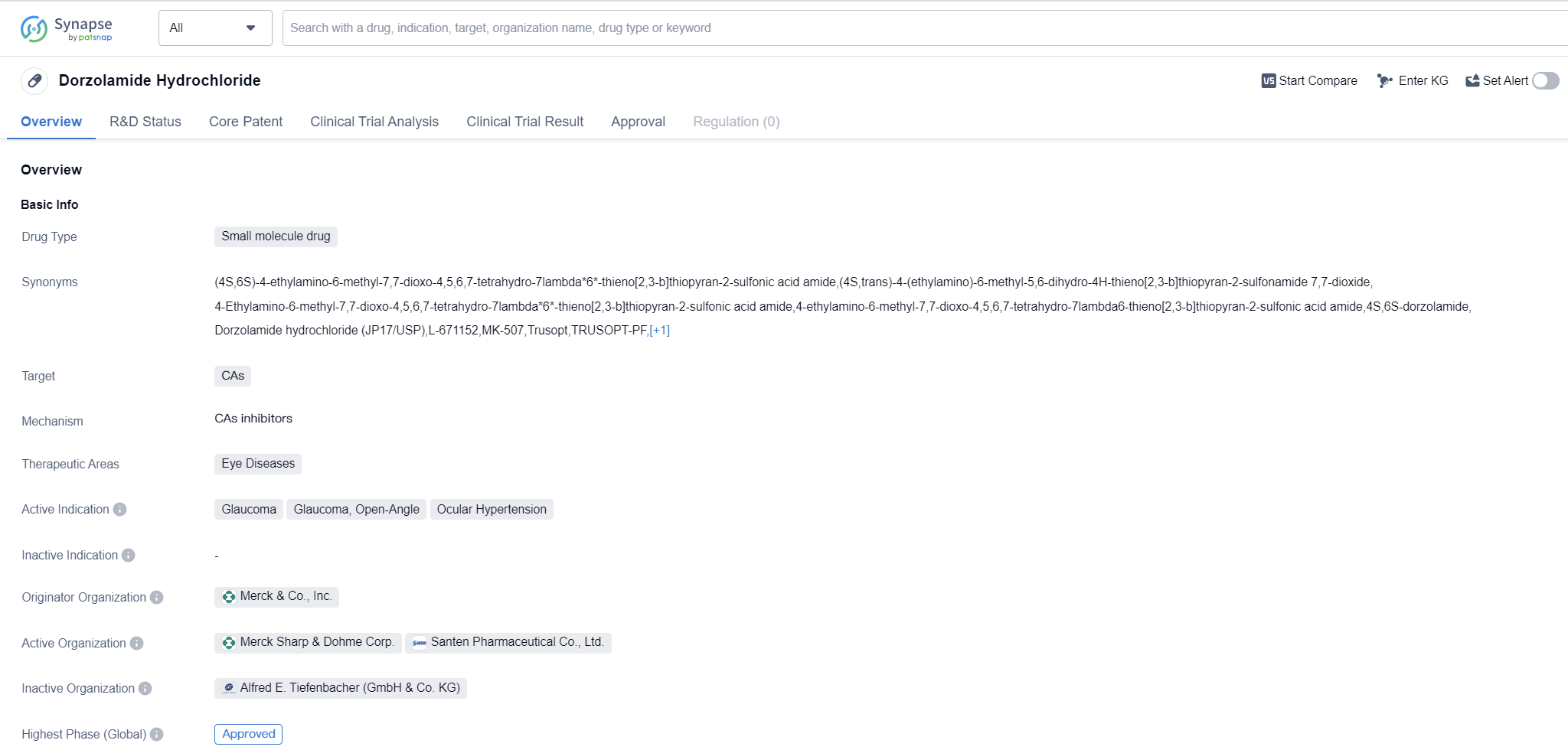dorzolamide hydrochloride Unveiled: A Detailed Overview of its Revolutionary R&D Breakthroughs
Dorzolamide hydrochloride's R&D Progress
Dorzolamide Hydrochloride is a small molecule drug that falls under the therapeutic area of eye diseases. It specifically targets carbonic anhydrases (CAs), which are enzymes involved in the production of aqueous humor in the eye. This drug is primarily used for the treatment of glaucoma, open-angle glaucoma, and ocular hypertension.
The originator organization of Dorzolamide Hydrochloride is Merck & Co., Inc., a renowned pharmaceutical company. The highest R&D phase of this drug is approved. It received its first approval in December 1994, making it a well-established medication in the market.
The initial approval of Dorzolamide Hydrochloride took place in the United States and New Zealand. These countries recognized the drug's efficacy and safety profile, allowing it to be marketed and prescribed to patients suffering from glaucoma and ocular hypertension.
Glaucoma is a chronic eye condition characterized by increased intraocular pressure, which can lead to optic nerve damage and vision loss if left untreated. Dorzolamide Hydrochloride works by reducing the production of aqueous humor, thereby lowering intraocular pressure and preventing further damage to the optic nerve.
As a small molecule drug, Dorzolamide Hydrochloride is typically administered topically in the form of eye drops. This route of administration ensures direct delivery to the affected area, maximizing its therapeutic effects while minimizing systemic side effects.
The approval and availability of Dorzolamide Hydrochloride have provided healthcare professionals with an effective treatment option for patients with glaucoma and ocular hypertension. By targeting CAs and reducing intraocular pressure, this drug helps manage the progression of these eye diseases and preserve vision.
👇Please click on the image below to directly access the latest data (R&D Status | Core Patent | Clinical Trial | Approval status in Global countries) of this drug.
Mechanism of Action for dorzolamide hydrochloride: CAs inhibitors
CAs inhibitors, also known as carbonic anhydrase inhibitors, are a class of drugs that inhibit the activity of the enzyme carbonic anhydrase. Carbonic anhydrase is an enzyme found in many tissues of the body, including the lungs, kidneys, and eyes. It plays a crucial role in the regulation of acid-base balance and fluid secretion.
From a biomedical perspective, CAs inhibitors are commonly used in the treatment of various medical conditions. For example, they are often prescribed to reduce intraocular pressure in patients with glaucoma, as carbonic anhydrase is involved in the production of aqueous humor in the eye. By inhibiting this enzyme, CAs inhibitors help to lower the pressure within the eye and prevent damage to the optic nerve.
CAs inhibitors are also used in the management of certain types of epilepsy. Carbonic anhydrase plays a role in the regulation of neuronal excitability, and inhibiting its activity can help to reduce the frequency and severity of seizures.
Furthermore, CAs inhibitors are utilized in the treatment of altitude sickness. When individuals ascend to high altitudes, the body responds by increasing ventilation to compensate for the lower oxygen levels. This can lead to respiratory alkalosis, a condition characterized by a decrease in blood carbon dioxide levels. CAs inhibitors can help to alleviate the symptoms of altitude sickness by inhibiting the enzyme responsible for the removal of carbon dioxide from the body, thus allowing for better adaptation to high altitudes.
Overall, CAs inhibitors are important therapeutic agents in various biomedical applications, including the management of glaucoma, epilepsy, and altitude sickness. By targeting carbonic anhydrase, these drugs help to modulate physiological processes and restore normal function in the body.
Drug Target R&D Trends for dorzolamide hydrochloride
CAs, or carbonic anhydrases, play a crucial role in the human body by catalyzing the reversible conversion of carbon dioxide (CO2) and water (H2O) into carbonic acid (H2CO3). This reaction is essential for maintaining the acid-base balance in various tissues and organs, including the lungs, kidneys, and digestive system. CAs also contribute to the regulation of fluid secretion and reabsorption, as well as the transport of ions such as bicarbonate and chloride. Additionally, these enzymes are involved in processes like bone resorption, neuronal signaling, and the production of aqueous humor in the eye. Understanding the role of CAs is vital for developing therapeutic interventions targeting various diseases, including glaucoma, epilepsy, and cancer.
According to Patsnap Synapse, as of 12 Sep 2023, there are a total of 87 CAs drugs worldwide, from 114 organizations, covering 85 indications, and conducting 807 clinical trials.
👇Please click on the picture link below for free registration or log in directly if you have a freemium account, you can browse the latest research progress on drugs, indications, organizations, clinical trials, clinical results, and drug patents related to this target
Conclusion
In summary, Dorzolamide Hydrochloride is a small molecule drug developed by Merck & Co., Inc. It is approved for the treatment of glaucoma, open-angle glaucoma, and ocular hypertension. With its first approval in 1994, this medication has been successfully used in the United States and New Zealand to reduce intraocular pressure and prevent optic nerve damage. By targeting CAs, Dorzolamide Hydrochloride offers a valuable therapeutic option for patients suffering from eye diseases.






